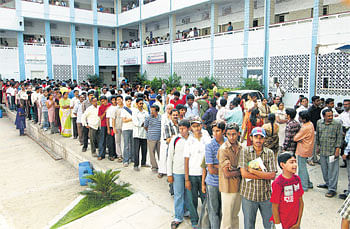
Karnataka’s GER is a mere 12.2 per cent, which indicates that 87.8 per cent of young people are not getting a college education. T V Mohandas Pai suggests remedies to pull the state out of this dismal situation
It is universally accepted that higher education is necessary for the creation of a knowledge society and for a fair, just social polity. A measure of the spread of higher education is the Gross Enrolment Rate (GER). GER is an index which measures the enrolment in higher education of the population in the age group of 18-24. The Karnataka Jnana Aayoga (KJA) sponsored a research study on the GER in Karnataka as part of its recommendations on higher education.
The results of the study make sad reading. Karnataka has a GER of 12.2 per cent with the GER for males being higher than for females. It means that 87.8 per cent of young people in the same age group are not getting a college education. If we compare the GER of other countries like China it is 22 per cent, Brazil 73 per cent, UK 59 per cent and USA 82 per cent. Of course the rest of India is no better but then the rest of India cannot be our benchmark. Karnataka should set its own standards and lead the rest of India.
Today, there are many jobs being created in the formal sector in Karnataka with a large number of jobs being filled by candidates from outside the State because of the low percentage of skilled and educated people being produced in the State. The GER in the northern part of Karnataka is even more pathetic, Gulbarga is 4.85 per cent, Hubli Dharward is 6.89 per cent! There is a need for a wholesale change in the entire strategy. This lack of investment in education is also reflected in the low level of per capita income outside Bangalore city.
The population of Karnataka is about 6 crore as per the 2011 census. The GSDP for fiscal 2012 is estimated at Rs. 450,000 crore out of an Indian GDP of Rs, 92,00,000 crore. Bangalore has about 50 per cent of the GSDP of Karnataka and for a population of 90 lakhs in greater Bangalore this comes to a per capita income of Rs. 250,000. The per capita income is high because of the jobs created by the IT industry and the service industry in general.
It also means that the rest of the population of Karnataka of 5.1 crore has a per capita income of only Rs. 44000. Northern Karnataka probably has income levels comparable to or lesser than Bihar without the growth Bihar is showing. Bangalore continues to be a magnet for India’s best and brightest and the income created by this talent shows in the high cost of real estate, the high tax collections both for the state and the centre and overall quality of life. In all this growth young people of Karnataka are losing out because they lack access to good education.
The state too is not spending much on higher education. Out of a total budget of Rs. 81000 crore odd, the spending on higher education is less than Rs. 1500 crore, most of this going for creation of infrastructure. The State Universities are starved for funds with over 35 per cent vacancies in faculty positions and have become examination bodies instead of educational institutions. Even of the total students in colleges a very high percentage is in the Arts faculties which basically is not oriented towards the real needs of the economy. Further, Karnataka has lost the edge in engineering that she had earlier with Andhra Pradesh, Tamil Nadu and Maharastra each graduating 50 per cent more engineers than Karnataka does and obviously doing much better in terms of educational output.
The situation needs to be remedied and drastic action taken if Karnataka has to regain her rightful place in India and elsewhere. This can only be done by increasing the GER, improving the quality of education and overall greater investment by the State in higher education. The study also brings out the reasons for the low GER and drop out rate in higher education. Thirty four per cent of the respondents cited economic reasons for the low GER with 20 per cent giving family as the reason. It is obvious that means continues to plague our young people when they choose their future.
There is thus a felt need for Karnataka to have a concerted plan and strategy to get the GER to at least 30 over the next 5 years and improve the economic condition of her young citizens. The only way out is to open up the higher education sector to both the private and public sector, increase investment and create a state-wide scholarship/freeship scheme so that every young person who desires to pursue higher education is given the means to do so through a scholarship and given the ability to choose his/her college/University of choice.
The investment in higher education and human development is totally inadequate for a state like Karnataka which boasts of a revenue surplus and a low debt to GSDP. The fiscal position can support a massive investment but what is lacking is the vision and the will. Our leaders are too willing to spend more money on subsidies and the like to get votes to stay in power but seem unwilling to invest in the only area which gives the largest returns to society, higher education. We need to change our policy before it is too late and we slip back further.
Karnataka has already lost its premier position in India and matters cannot wait anymore if we have to make the future better for all of us.
(The writer is Chairman, Manipal Global Education Services)